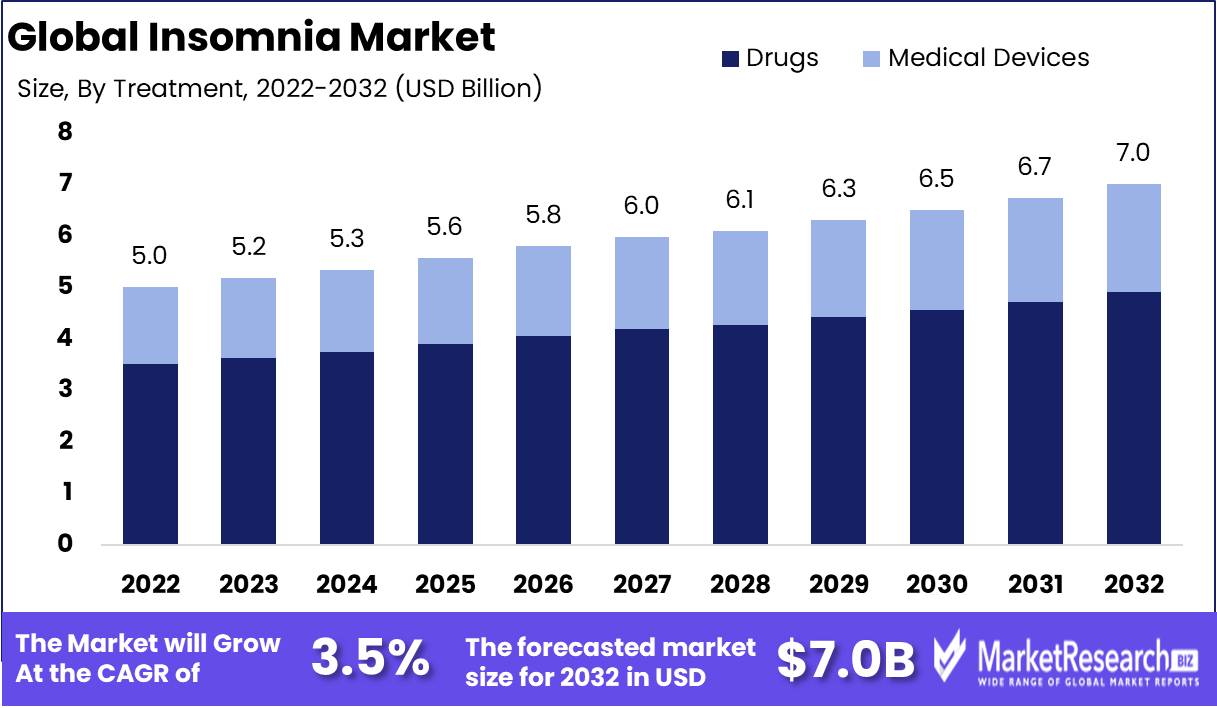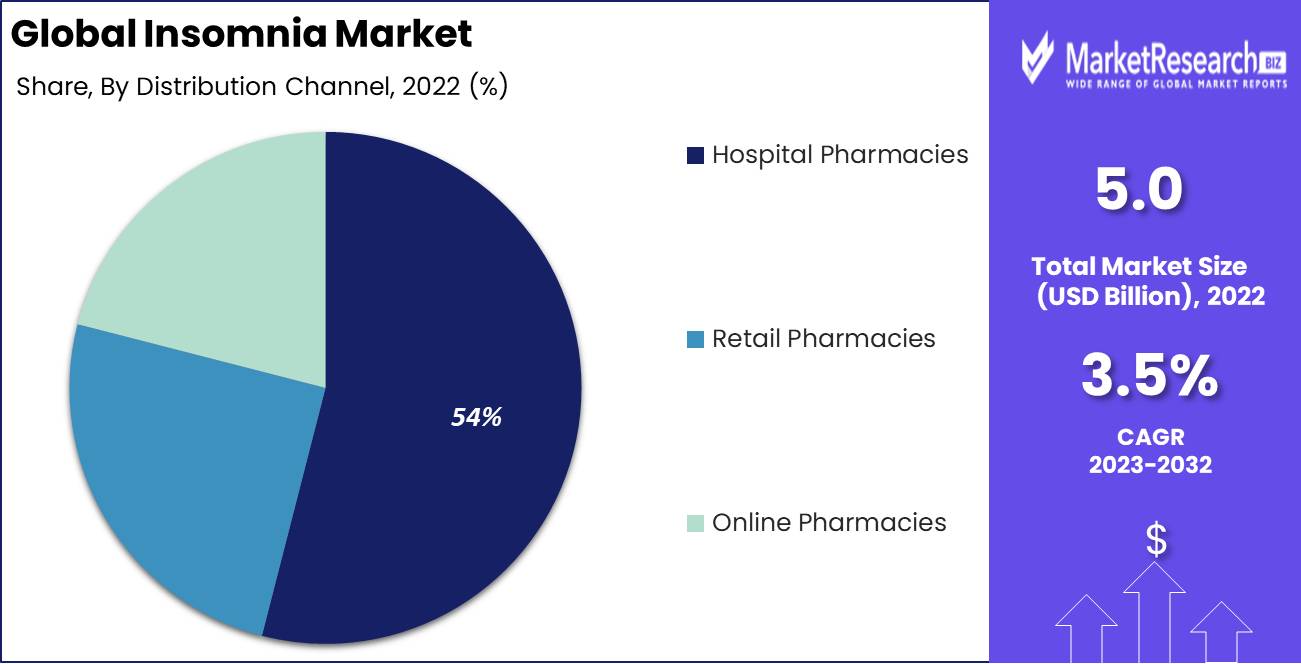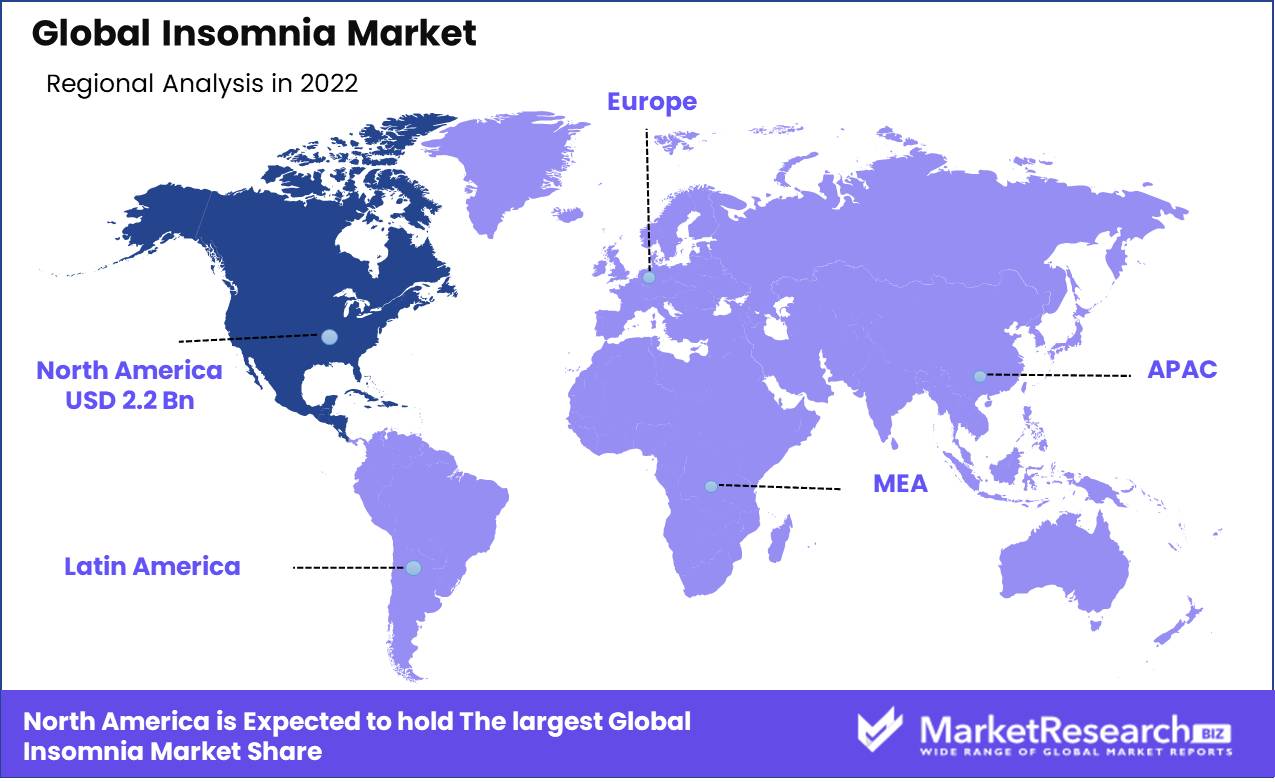
Global Insomnia Market By Treatment (Drugs and Devices), By Distribution Channel (Hospital Pharmacies, Retail Pharmacies, and Online Pharmacies), By Region and Companies - Industry Segment Outlook, Market Assessment, Competition Scenario, Trends, and Forecast 2023-2032
-
306
-
June 2023
-
158
-
-
This report was compiled by Correspondence Linkedin | Detailed Market research Methodology Our methodology involves a mix of primary research, including interviews with leading mental health experts, and secondary research from reputable medical journals and databases. View Detailed Methodology Page
-
Report Overview
Global Insomnia Market size is expected to be worth around USD 7.0 Bn by 2032 from USD 5.0 Bn in 2022, growing at a CAGR of 3.5% during the forecast period from 2023 to 2032.
Insomnia is termed a sleep disorder that leads to trouble falling asleep. It can lower energy levels, can affect the health, mood, and overall life quality of an individual. Stress, hectic work schedules, long travels, poor sleep habits, as well as excessive consumption of alcohol, nicotine, and caffeine are the most common causes of insomnia. It is also associated with mental health disorders, such as post-traumatic stress disorder (PTSD). This condition can be treated by drugs, therapies (cognitive behavioral therapy), and medical devices. The market expansion is mainly influenced by the rising prevalence of insomnia across the globe, the increasing geriatric population, growing stress levels, and rising awareness regarding a variety of treatment options to treat this condition.

Market Scope
Treatment Analysis
The drugs segment dominated the global insomnia market in 2022
Based on treatment, the market for insomnia is segmented into drugs and devices. The drug segment is further subdivided into orexin antagonists, antidepressants, benzodiazepines, nonbenzodiazepines, melatonin antagonists, and other drugs. Among these treatments, the drugs segment held the largest revenue share in the global market. This dominance is largely due to the increasing use of orexin antagonists for the treatment of insomnia.
Orexin antagonist segment is estimated to dominate during the forecast period because of the reduced harmful ADRs that restrain the use of numerous treatment options for several patients. Lemborexant, suvorexant, and daridorexant are some of the orexin antagonists. These drugs act as a potent dual orexin receptor antagonist which blocks both the receptors, OX1R and OX2R. This increases sleep by inhibiting orexin-A and B neuropeptides promoting wakefulness.
As a result, the drug segment is anticipated to expand more during the forecast period. Moreover, product development activities and product approvals are likely to fuel the market growth in this segment over the forecast period.
Distribution Channel Analysis
The hospital pharmacies held the largest revenue share in 2022
By distribution channel, the market is further divided into hospital pharmacies, retail pharmacies, and online pharmacies. Among these types, hospital pharmacies accounted for the largest revenue share in 2022. This significant share can be largely attributed to the rising awareness of insomnia among individuals.

The increase in the use of prescription drugs is a major driver contributing to the segment's growth. Insomnia needs to be treated under the supervision of a medical professional as it can be caused due to various factors and conditions. The drug dosage for this condition needs to be administered at accurate frequency and time. Hence, the majority of drugs for this condition are to be sold only under the doctor’s prescription. As a result, hospital pharmacies ensure the high availability of these drugs, thereby supporting the revenue growth of this segment.
Key Market Segments
Based on Treatment
- Drugs (Orexin Antagonists, Antidepressants, Benzodiazepines, Nonbenzodiazepines, Melatonin Antagonists, and Other Drugs)
- Medical Devices
Based on Distribution Channel
- Hospital Pharmacies
- Retail Pharmacies
- Online Pharmacies
Market Dynamics
Drivers
Rising geriatric population drives the market growth
Older individuals mostly above 65 years are at higher risk of developing several diseases that can lead to reduced sleep. Refractive errors, sleep issues, cataracts, and hearing loss are common in aged individuals. A higher ratio of the geriatric population is facing sleeping issues across the globe. Thus, the increase in the aged population is likely to result in a rising number of insomnia cases. As a result, the global insomnia market is further expected to expand significantly over the forecast period.
Increasing government investments in the healthcare sector to boost market growth
Increasing healthcare costs and earlier disease diagnosis due to increased awareness of treatment options are major factors expected to boost the market growth during the forecast period. Growing investments in the healthcare sector by several governments are one of the major drivers for the insomnia market's growth.
Governments from several countries have increased their investments in improving the healthcare systems earlier when the spread of the COVID-19 pandemic started. Owing to the pandemic's impact lessening, a number of hospitals are currently focused on the use of these resources for the treatment of other severe diseases. The global insomnia market is considerably expanding as a result of an increase in government investments in the healthcare sector.
Restraints
High Cost associated with diagnosing and treating insomnia
Expensive diagnosis and treatment of insomnia is the primary factor constraining the expansion of the insomnia market. In addition, the term 'sleeping disorder' covers a higher range of illnesses having considerable harmful effects on an individual's health. Insomnia is associated with heavy medical and financial burdens. Each year, insomnia patients spent twice much on direct medical care rather than patients those are without this condition. As a result, the insomnia market growth is expected to be hampered due to the higher cost of diagnosis and medication.
Opportunity
Several therapies for insomnia and a large patient pool in developing countries offer numerous growth opportunities
Cognitive behavioral therapy for insomnia (CBT-I) is found to be the most effective treatment option currently and is first-line therapy. Additionally, sleep-restriction therapy (SRT), sleep hygiene and education (SHE), stimulus control therapy (SCT), and relaxation therapy are some other therapies used to treat insomnia.
Emerging economies such as India and China are anticipated to witness an increase in demand for sleep aids and other healthcare facilities during the forecast period. This will likely end up creating a number of opportunities for prominent market players, who are planning to expand their revenue and presence in these regional markets. An increase in the undiagnosed patient pool suffering from insomnia suggests that there is a significant level of insomnia among the worldwide population, which prompts the critical necessity for improved diagnosis, recognition, and treatment.
Trends
Launch of new drugs and rising adoption of generics to propel the market growth
Launch of new drugs as well as rehabilitation services is one of the major drivers for the insomnia market. Additionally, rising government support across several countries is influencing key players to indulge and invest in the R&D of new drugs. Moreover, factors such as growing generics adoption, which are cost-effective while providing equal efficacy as that of branded products, are likely to fuel the expansion rate of the global insomnia market over the forecast period.
Regional Analysis
North America dominated the global insomnia market in 2022
Based on region, the global insomnia market is divided into North America, Europe, Asia Pacific, Latin America, and Middle East & Africa. Among these regions, North America accounted for the highest revenue share in 2022. It is also expected to dominate the global insomnia market over the forecast period. Rising need for treatment of sleep disorders in the Canada and United States, coupled with the rising prevalence of sleep disorders, is anticipated to surge the market growth rate over the forecast period.
Additionally, the rise in sleep-related disorders is also the impact of depression, obesity hypertension, cancer, and many more diseases that are higher in this region. Moreover, the well-established healthcare infrastructure and higher incidence of work-related stress are likely to propel the market growth in this region. In addition, the market for insomnia in the Asia Pacific region is expected to expand at a significant CAGR during the forecast period owing to the higher population base, rising number of aged individuals, and odd-time work shifts.

Key Regions
- North America
- The US
- Canada
- Mexico
- Western Europe
- Germany
- France
- The UK
- Spain
- Italy
- Portugal
- Ireland
- Austria
- Switzerland
- Benelux
- Nordic
- Rest of Western Europe
- Eastern Europe
- Russia
- Poland
- The Czech Republic
- Greece
- Rest of Eastern Europe
- APAC
- China
- Japan
- South Korea
- India
- Australia & New Zealand
- Indonesia
- Malaysia
- Philippines
- Singapore
- Thailand
- Vietnam
- Rest of APAC
- Latin America
- Brazil
- Colombia
- Chile
- Argentina
- Costa Rica
- Rest of Latin America
- Middle East & Africa
- Algeria
- Egypt
- Israel
- Kuwait
- Nigeria
- Saudi Arabia
- South Africa
- Turkey
- United Arab Emirates
- Rest of MEA
Key Players Analysis
Emerging key players are largely focused on the development of various strategic policies for their respective businesses in foreign markets. Several companies in the global insomnia market are focusing on the expansion of their R&D activities and existing operations. Furthermore, major players in the insomnia market are involved in the development of new products, investments, mergers & acquisitions, collaboration, and partnerships, thereby forming the competitive landscape in the market. As a result, these strategies are highly supporting the global insomnia market growth.
Listed below are some of the most prominent insomnia market players.
Market Key Players
- Pfizer Inc.
- Takeda Pharmaceutical Company Ltd.
- Sanofi S.A.
- Idorsia Pharmaceuticals Ltd
- Electromedical Products International, Inc.
- Merck & Co., Inc.
- Aurobindo Pharma Limited
- Astellas Pharma Inc.
- Sumitomo Dainippon Pharma Co. Ltd.
- Neurim Pharmaceuticals Ltd.
- Sun Pharmaceutical Industries Ltd
- Other Key Players
Recent Developments
- In January 2022, Idorsia got approval from the US FDA for its QUVIVIQ 25 and 50 mg for the treatment of insomnia in adults, characterized by difficulties with the onset of sleep and sleep maintenance.
- In May 2022, European Commission approved the marketing authorization for QUVIVIQ, manufactured by Idorsia Ltd, which is indicated for the treatment of insomnia in adults characterized by symptoms present at least for three months and considerable impact on daytime functioning.
Report Scope
Report Features Description Market Value (2022) USD 5.0 Bn Forecast Revenue (2032) USD 7.0 Bn CAGR (2023-2032) 3.5% Base Year for Estimation 2022 Historic Period 2016-2022 Forecast Period 2023-2032 Report Coverage Revenue Forecast, Market Dynamics, COVID-19 Impact, Competitive Landscape, Recent Developments Segments Covered By Treatment - Drugs and Devices; By Distribution Channel - Hospital Pharmacies, Retail Pharmacies, and Online Pharmacies Regional Analysis North America – The US, Canada, & Mexico; Western Europe – Germany, France, The UK, Spain, Italy, Portugal, Ireland, Austria, Switzerland, Benelux, Nordic, & Rest of Western Europe; Eastern Europe – Russia, Poland, The Czech Republic, Greece, & Rest of Eastern Europe; APAC – China, Japan, South Korea, India, Australia & New Zealand, Indonesia, Malaysia, Philippines, Singapore, Thailand, Vietnam, & Rest of APAC; Latin America – Brazil, Colombia, Chile, Argentina, Costa Rica, & Rest of Latin America; Middle East & Africa – Algeria, Egypt, Israel, Kuwait, Nigeria, Saudi Arabia, South Africa, Turkey, United Arab Emirates, & Rest of MEA Competitive Landscape Pfizer Inc., Takeda Pharmaceutical Company Ltd., Sanofi S.A., Idorsia Pharmaceuticals Ltd, Electromedical Products International, Inc., Merck & Co., Inc., Aurobindo Pharma Limited, Astellas Pharma Inc, Sumitomo Dainippon Pharma Co. Ltd., Neurim Pharmaceuticals Ltd., Sun Pharmaceutical Industries Ltd, and Other Key Players Customization Scope Customization for segments, region/country-level will be provided. Moreover, additional customization can be done based on the requirements. Purchase Options We have three licenses to opt for: Single User License, Multi-User License (Up to 5 Users), Corporate Use License (Unlimited User and Printable PDF) -
-
- Pfizer Inc.
- Takeda Pharmaceutical Company Ltd.
- Sanofi S.A.
- Idorsia Pharmaceuticals Ltd
- Electromedical Products International, Inc.
- Merck & Co., Inc.
- Aurobindo Pharma Limited
- Astellas Pharma Inc.
- Sumitomo Dainippon Pharma Co. Ltd.
- Neurim Pharmaceuticals Ltd.
- Sun Pharmaceutical Industries Ltd
- Other Key Players




